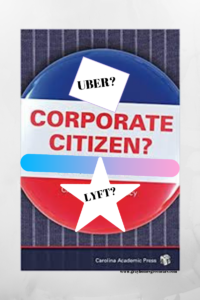
Uber and Lyft are now publicly traded companies, but it is notable that neither of them signed on to the widely acclaimed corporate governance pledge (Wall Street Journal, 8/19/2019). Rideshare CEO’s probably feel that corporate citizenship and community participation have always been core values, but the general public may not agree. Nearly two hundred CEO’s from America’s best known and largest companies, but not ride-hailing, endorsed a new code of corporate ethics from the Business Roundtable.
I recently participated in a civic panel that had to “convince” authorities in local governmental to view rideshare, namely Uber and Lyft, as the solution, not the enemy, for local transportation needs. It was a hypothetical exercise, but we came away from it with a renewed appreciation for the civic role that rideshare companies could play. There were lessons for rideshare that support the goals of the governance pledge.
Their naysayers entered our exercise with the view that rideshare was the progenitor of new road congestion, curb disputes, and falling transit ridership. They also viewed rideshare as a potential threat to municipal coffers from reduced parking revenue and taxi medallions. That said, they came away from our exercise with a new appreciation for working cooperatively with Uber and Lyft.
Shareholders or Stakeholders?
In our hypothetical exercise which took place in a real city hall, the panelists noted that Uber and Lyft should focus civic efforts on the next generation. They identified a need to collaborate with local high schools and job centers. Noting that many kids will not go on to college, they identified the need to develop vocational skills. The civic minded panelists suggested that Uber and Lyft set up forward-looking training programs so that students learn about alternative fuels and energy. They could participate in sourcing bio-diesel from local sources. The concept is that technical training will prepare kids for jobs ten and twenty years out, equipping them to work on electric and bio-diesel vehicles, not just gasoline cars. (note: in some communities, Uber already promotes electric vehicles)
Along the same line of thought, the panel recognized that Uber and Lyft have an ever increasing need for drivers. That is, until the roll out of autonomous vehicles. They thought that rideshare companies could provide outreach to the unemployed or underemployed and even help them procure vehicles to drive. This might increase the supply of part and full time drivers. (again, uber and lyft encourage part-time drivers).
Support Mobility
The charge of our panel was to “convince” government authorities that rideshare companies, namely Uber and Lyft, were their partners when it came to improving local transportation. The panel seized upon the need to work with local government to enable, and improve, first and last mile trip taking. The goal, as you would expect, was not to put public transit out of business or cannibalize service, but rather, to make it more accessible and practical for riders. Transit agencies cannot provide door-to-door service, and mass transit does not reach to the outer-ends of the sprawled city. So, the panel suggested that Uber and Lyft operate many different types and sizes of vehicles, and expand upon shared-ride and van-type services. In fact, Uber and Lyft do this in many cities today.
Expand into Freight
Freight logistics also got a boost from the panel. While no one saw drone delivery as the immediate answer to congestion, rideshare algorithms were viewed as a potential solution for freight delivery. It was thought that smarter logistics could reduce the total number of delivery vehicles on the road, bundle loads, and juggle the time-slot for deliveries. At the extreme, pallets could be off-loaded to designated Uber and Lyft owner- driven vans and deliver goods outside peak commuting hours.
Taxing Efforts
The panel’s most far-reaching recommendation for local government was to impose a tax, but not just on rideshare. The tax would be levied on drivers who did SOV (single occupancy vehicle) commutes and single rideshare trips. Many states, from California to Massachusetts, currently impose a tax on the transportation network companies. This ten to twenty cent fee per ride is typically turned back by city government into more transportation projects, or in the case of California, into subsidizing more wheelchair assisted vehicle (WAV) rides. The panel’s intention with the tax was to end the privilege of being a single car owner and accelerate more shared (2+ rider) trips using rideshare.
Summing Up with ‘Surprise’ for Governance
The curious thing about rideshare is that Uber and Lyft have programs in place today that do serve underprivileged populations, expand first and last mile trip taking, and work alongside public transit. These individual programs are splattered across the country and receive occasional attention within individual communities and are known among transportation planners. However, the latter group has often been estranged by the reluctance of Uber and Lyft officials to share local rideshare data and numbers.
Now that Uber and Lyft have become public companies, sharing information may become more standard and routine. When they do so, there could be benefits. As rideshare companies continue to expand their transportation footprint and develop entirely new markets, they might find, surprise, that local governments are a close ally and new partner. Meanwhile, local government, surprise, might find that rideshare will be the solution to their many small but vexing mobility problems.